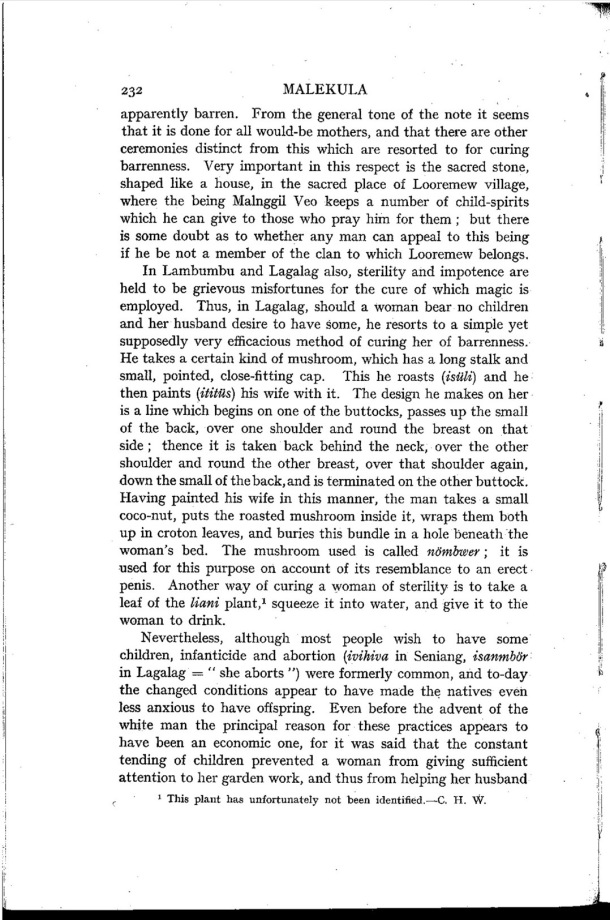|
|  [Note: this transcription was produced by an automatic OCR engine]
232 MALEKULA
apparently barren. From the general tone of the note it seems
that it is done for all would-be mothers, and that there are other
ceremonia DISTINCT from this which are resorted to for curing
barrenness. Very important in this respect is the sacred stone,
shaped like a house, in the sacred place of Looremew village,
where the being Malnggil Veo keeps a number of chi1d—spirits
which he can give to those who pray him for them ; but there
is some doubt as to whether any man can appeal to this being
if he be not a member of the clan to which Looremew belongs.
In Lambumbu and Lagalag also, sterility and impotence are
held to be grievous misfortunes for the cure of which magic is
employed. Thus, in Lagalag, should a woman bear no children
and her husband desire to have Some, he resorts to a simple yet
supposedly very eiï¬Åcacious method of curing her of barrenness.
He takes a certain kind of mushroom, which has a long stalk and
small, pointed, close-ï¬Åtting cap. This he roasts (isttlij and he
then paints (ititils) his wife with it. The design he makes on her
is a line which begins on one of the buttocks, passes up the small
of the back, over one shoulder and round the breast on that
side; thence it is taken back behind the neck, over the other
shoulder and round the other breast, over that shoulder again,
down the small of the back, and is terminated on the other buttock.
Having painted his wife in this manner, the man takes a small
coco—nut, puts the roasted mushroom inside it, wraps them both
up in croton leaves, and buries this bundle in a hole beneath the
woman’s bed. The mushroom used is called niimbwer; it is
used for this purpose on account of its resemblance to an erect
penis. Another way of curing a woman of sterility is to take a
leaf of the liani plant,‘ squeeze it into water, and give it to the
woman to drink.
Nevertheless, although most people wish to have some
children, infanticide and abortion (ivihiva in Seniang, isanmbiir
in Lagalag = “ she aborts ") were formerly common, and to-day
the changed conditions appear to have made the natives even
less anxious to have offspring. Even before the advent of the
white man the principal reason for these practices appears to
have been an economic one, for it was said that the constant
tending of children prevented a woman from giving sufficient
attention to her garden work, and thus from helping her husband
1 This plant has unfortunately not been iLlentiï¬Åed.AC. H4 W.
“W
ll
ll
v
r;l
gun: _._:_
1;
la
_ _V%_,_._,.
_ _,_<_
2*
|